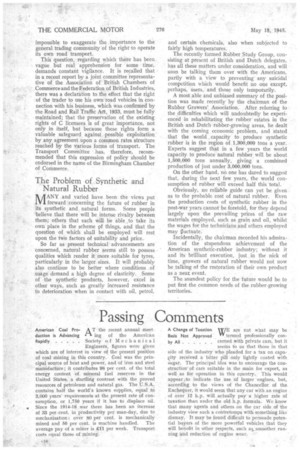Passing Comments
Page 18

Page 19

If you've noticed an error in this article please click here to report it so we can fix it.
American Coal ProA T the recent annual meetduction is Advancing ra ing of the American Rapidly . . . . . Society of Mechanical Engineers, figures were .given which are of interest in view of the present position of coal mining in this country. Coal was the principal source of heat and power, and of iron-and steel manufacture; it contributes 98 per cent. of the total energy content of mineral fuel reserves in the United States-, a startling contrast with the proved resources of petroleum and natural gas. The U.S.A. contains half the world's known supplies, equalto 3,000 years' requirements at the present rate of consumption, or 1,750 years if it has to displace oil.
* Since the 1914-18 war there has been an increase of 33 per cent. in productivity per man-day, due to mechanization ; over 80 per cent. is mechanically mined and 50 per cent. is machine handled. The average pay of a miner is £11 per week. Transport costs equal those of mining. A Change of Taxation WE are not what may be
Basis Not Approved VY termed professionally con
by All cerned. with private cars, but it
seems to us that those in that side of the industry who pleaded for a tax on capacity received a bitter pill only lightly coated with sugar. The principal idea was to encourage the construction` of cars suitable in the main for export, as well as for operation in this country:. This would appear AD indicate the use Of larger 'engines, bitt, according, to the views of the Chancellor of the Exchequer, it would seemthat any car with an engine of over .12 h.p. will actually pay a .higher rate of taxation than under the old .h.p. formula. We know that many agents and others on the car side of the industry view such a contretemps with something like. dismay. It may be found difficult to persuade potential buyers of the more powerful vehicles that they will benefit in other respects, such n, smoother run
ning and redaction of engine wear, ' THERE is far more in a
pneumatic tyre than meets the eye,, and a tyre designer must cope with many factors, apart from the mere capacity to carry the load for which the tyre is produced. One of the most important of these is that of reducing the heat produced and dissipating the remainder. In the latter connection, much depends upon the design of the tread. Tyres become most heated at the shoulders. Therefore, wide, deep channels are often provided to ensure maximum ventilation. Deep and wide grooves in the tread also help this, whilst notching of the sides reduces the risk of cracking, which is particularly important with .synthetic rubber. Then there are types such as those employed on crosscountry work, which are liable to consideratIle bruising. In these cases, buffers are sometimes inserted in the treads, these comprising several layers of rubbercoated fabrie insulated with special shock-resisting rubber.
Commercial vehicle Tyre Design. . .
Three Stages in ProA N indication of the almost ducing a. Single 1--k unbelievable reduction in
Article . . . . the costs of production which
can be attained when conditions warrant the adoption of mass-production methods is given in a Ministry, leaflet urging the necessity of using theft methods in the interests of manpower and capital cost of plant, to say nothing of the reduced cost, and the impossibility of producing sufficient volume of a commodity unless such methods be adopted. A batch of small face-plate-shaped articles, about 3 ins, in diameter, was the case in point; in the first instance it was being made on centre lathes, 4 along with drilling machines, requiring 33 machines and 76 operators. When made on capstan lathes, only 12 machines and 30 operators were needed, whilst using six spindle automatic chucking machines. it required only four of these and 10 operators. In each case two shifts per day were worked. Thus the machines were reduced to one-eighth the number, as was the labour involved.




















































